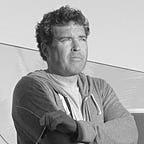We All Like To Look Away Sometimes (I Feel So Much Better Now)
We All Like To Look Away Sometimes (I Feel So Much Better Now) is a story of survival. The narrative starts with what seems benign: Across cultures, if we have been troubled, we want to feel better — we want to feel relief; we want equanimity restored. Out from discomfort, we seek peace. By excluding the unpleasant, we believe we reach personal calm.
The narrative hints perhaps at contempt for such notions, given their implications for societies and humanity, if personal ease is to be gained by declining to look, or help, or save. If all of us — “we all” — practice societal-level disengagement in favor of each our own “I” — is that not how societies, democracies — even whole civilizations — have historically not survived? Once such rot upon the social contract and citizenry takes root, the decay begins. The loss of the group, in favor of each person as one — a looking away like this, of this magnitude, and to this change itself — it historically marks a society whose survival will not go on. So have we lessened our chances of survival by our looking away, and even if we feel better as the result?
The narrative then pivots to ask, instead, what if looking away is exactly what evolution wants? Doesn’t every species look away, choosing to protect only their own pack, their or pride? Only their own territory, nothing beyond? Is looking away what our minds — our souls — now need to do to survive? For our entire existence as a species, until the past century, we lived in small groups — and now in the past century, we are asked to have empathy for an entire world, for eight billion people — and we are asked to have the ability, and desire, and stamina, to daily be of global use, to daily bear global witness, to help, to solve, to help an infinite village survive.
On this, the work asks, maybe our evolution knows that it has left us unable, ill-equipped, to summon enough empathy, enough utility, the requisite comprehension, to be of use on a global scale. That evolution has not prepared us for the compassion, the desire, the ability, to be of use to our fellow humanity — not at this level, across a planet, about the planet, always before us, in these times. What if we need to look away because when we try to be global citizens in the truest meaning of the world we lack the capacity and must retreat to varying degrees in order to survive.
If so, it is a brutal exchange that comes down to binary survival, the guts of our story as seen in this particular frame: I cannot save you, by brothers and my sisters, I must in fact shut down — and look away — so that I myself can survive. Under this version of the narrative, the election to live only in one’s small valley, as for millennia we have done until this past instant of time, may be more than just an act of avoiding discomfort in order to seek an easy peace or calm. It may instead be an act of raw survival in a time and place we were never meant to be — global citizens, that citizenship thrust upon us, so suddenly, each of us thrust into constant omniscience as to the struggles of eight billion fellow humans who range upon almost two-hundred million square miles of what used to be simple valleys and farms.
This work visually references both Ruscha and Sugimoto, placing a short text statement over a natural expanse, here a horizon between water and air. The image also references Rothko and color theory, as the darker blue below turns to an area of neutral before coming to a lighter blue. The image, a small detail of appropriated and altered public domain media, relies heavily on the color blue in two shades, representing two things — not just traditional blue as a symbol of potential melancholy in art history, but also, in its occasional more modern use, as a symbol to represent concepts of absolute and infinite expansiveness — as interpreted here to reference the seeming infinity of the new and sudden global everything of the past century, thrust upon the individual’s mind and heart.
Empirically, the work draws upon Western academic research regarding universal emotions, the capacity of the human mind for comprehension, empathy, and compassion, Western notions of time, Eastern notions of impermanence, and Eastern notions of the invisible spaces, or negative spaces, that may create and define relations — referenced here visually in the almost colorless area, behind the text, that is not quite either the troubling blue below or the tranquil blue of the sky. Finally, in capturing the themes and references summarized in the essay, the physical execution, and the meanings in the work, this piece has approximately 20–25 layers, including a final two layers of hand-painted oil paint, which, if you look closely, set forth shaking marks due to the artist’s unique “lithium brushstroke.”
